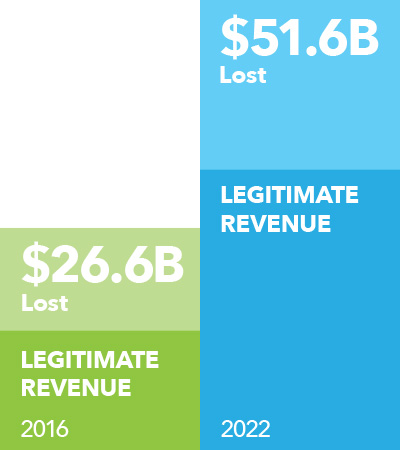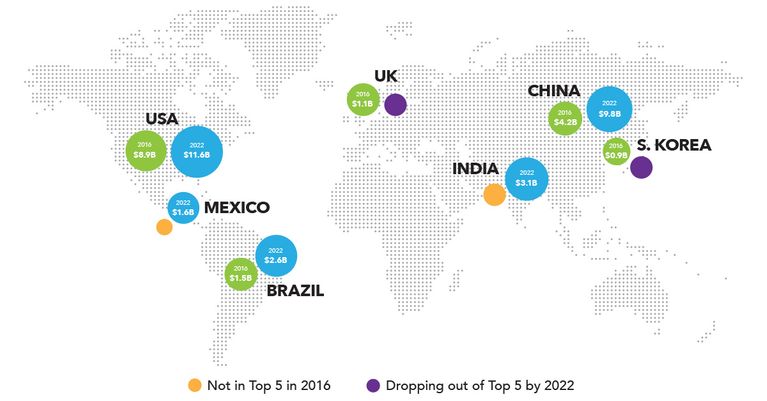Content piracy is big. It’s costly. And it’s a growing ROI problem for content owners and distributors across the globe.
Unlike previous, closed systems, today’s digital delivery system makes it easier for pirates to steal and re-stream illegal content anywhere in the world, using the same type of infrastructure used by the service providers themselves.
What the Piracy Research Says
Due to its clandestine nature, as well as wide-ranging touchpoints, establishing solid numbers for piracy and the financial impact it has is difficult, leading to disparities in estimates. But one thing is clear — the numbers are high. Piracy research released in a June 2019 study (conducted jointly by the U.S. Chamber of Commerce, the Global Innovation Policy Center and NERA Economic Consulting) looked at the global impact of paid digital TV and online movie piracy on the U.S. economy. It estimated that lost revenues amounted to at least $29.2 billion every year — and maybe much more — with over 80% of that piracy happening via streaming. While lost revenue is the most obvious result, the piracy research study noted that widespread online movie piracy also leads to job losses and reduced GDP, potentially displacing hundreds of thousands of jobs across the video content, production and distribution value chain in the U.S. alone.
 A further study carried out by Digital TV Research predicted that digital TV and online movie piracy across 138 countries will nearly double from 2016 to 2022, meaning that there could be as much as $51.6 billion in lost revenue for content owners.
A further study carried out by Digital TV Research predicted that digital TV and online movie piracy across 138 countries will nearly double from 2016 to 2022, meaning that there could be as much as $51.6 billion in lost revenue for content owners.
According to a recent piracy research presentation by our partner Friend MTS, the most impacted segments from piracy are premium sports and entertainment — with TV revenue loss estimates approaching $35bn in 2018 (based on a Digital TV Research estimate of 2018 global TV revenues). Given the magnitude of these losses, it is not surprising that advertising revenue is also suffering: “It’s a worldwide problem that affects the whole chain from rights owners to pay-TV platforms. Piracy is now a sophisticated, industrial scale problem, with more than 3,000 black market pirate services. Recent estimates show the top 600 pirate sites generating $260 million of advertising revenue.” That’s revenue lost by legitimate sources.
Online Movie Piracy Forcing Changes
Content piracy is so big that its impact is felt beyond the bank account — it’s changing business models. Traditionally in the movie business, new releases often stayed in theaters for months to maximize revenues. As digital downloads, and now streaming, have made it easier for content pirates to obtain and distribute illegal copies, movie studios have continually shrunk the release window over the last several years, moving to get their latest blockbuster online before pirates gain traction with their illegal copies and eat into ROI. With secondary release windows now down to weeks (or even less in some cases), studios must focus on protecting their investment inside and outside the theater.
The Value of OTT Live Sports Is on the Rise
Looking beyond entertainment, the growing popularity of live over-the-top (OTT) sports is prompting many cord-cutters, out of home viewers, and those without local access to view their favorite teams, to turn to piracy sites — sometimes unwittingly — to keep up with the action. As noted in our previous piracy research blog post in this series, 54% of millennials admitted to researchers to having watched illegal streams of live sports – one-third of them regularly. Unlike pirated TV shows or movies, the value of a sporting event is fleeting, with revenue being lost in a very small window. If stakeholders aren’t fighting piracy in real time and in collaboration with others across the delivery chain, losses can increase rapidly.
With more and more fans streaming their favorite live sports, the cost to obtain streaming rights for the world’s top leagues is rising, spurred by competition from new media (non-broadcast) companies such as Twitter, Amazon and new direct-to-consumer (DTC) subscription services like DAZN. Verizon paid over $2 billion for the non-exclusive right to live-stream most National Football League (NFL) games to their mobile customers over a five-year period through the 2022-2023 season; and DAZN has been winning streaming rights all over the world — from the J. League in Japan to the EuroLeague and the NTT IndyCar Series in Brazil. As more streaming sports services emerge to meet the demand for legitimate OTT viewing, the cost of piracy to rights owners will climb along with it.
Protecting the Bottom Line
While many things have changed in the content world, the need for content owners and distributors to protect their bottom line remains the same. Live sports, TV and online movie piracy is a serious threat to ROI, requiring a holistic solution — spanning the delivery chain — to protect their investment. In our next blog post in this series we’ll start to assemble the full “puzzle of tools” needed for combating piracy.
If you missed the first post in this series, take a look now. If you have any questions, please reach out to our team.








